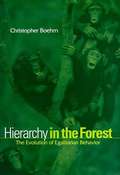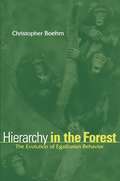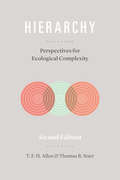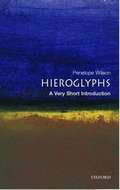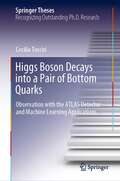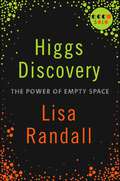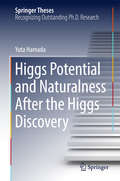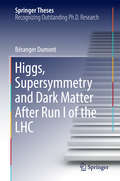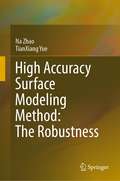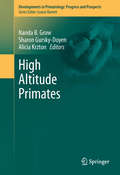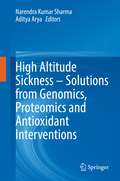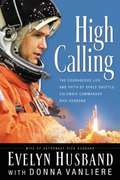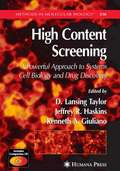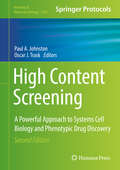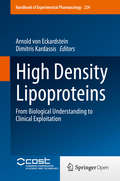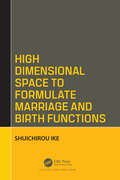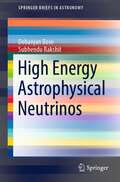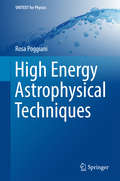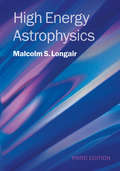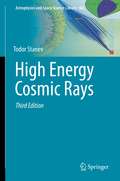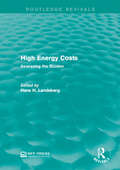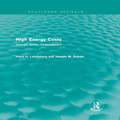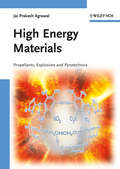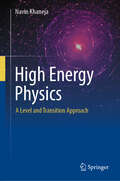- Table View
- List View
Hierarchy In The Forest: The Evolution Of Egalitarian Behavior
by Christopher BoehmAre humans by nature hierarchical or egalitarian? Hierarchy in the Forest addresses this question by examining the evolutionary origins of social and political behavior. Christopher Boehm, an anthropologist whose fieldwork has focused on the political arrangements of human and nonhuman primate groups, postulates that egalitarianism is in effect a hierarchy in which the weak combine forces to dominate the strong. The political flexibility of our species is formidable: we can be quite egalitarian, we can be quite despotic. Hierarchy in the Forest traces the roots of these contradictory traits in chimpanzee, bonobo, gorilla, and early human societies. Boehm looks at the loose group structures of hunter-gatherers, then at tribal segmentation, and finally at present-day governments to see how these conflicting tendencies are reflected. Hierarchy in the Forest claims new territory for biological anthropology and evolutionary biology by extending the domain of these sciences into a crucial aspect of human political and social behavior. This book will be a key document in the study of the evolutionary basis of genuine altruism. Table of Contents: The Question of Egalitarian Society Hierarchy and Equality Putting Down Aggressors Equality and Its Causes A Wider View of Egalitarianism The Hominoid Political Spectrum Ancestral Politics The Evolution of Egalitarian Society Paleolithic Politics and Natural Selection Ambivalence and Compromise in Human Nature References Index Reviews of this book: This well-written book, geared toward an audience with background in the behavioral and evolutionary sciences but accessible to a broad readership, raises two general questions: 'What is an egalitarian society?' and 'How have these societies evolved?'. . . [Christopher Boehm] takes the reader on a journey from the Arctic to the Americas, from Australia to Africa, in search of hunter-gatherer and tribal societies that emanate the egalitarian ethos--one that promotes generosity, altruism and sharing but forbids upstartism, aggression and egoism.
Hierarchy in the Forest: The Evolution of Egalitarian Behavior
by Christopher BoehmAre humans by nature hierarchical or egalitarian? Hierarchy in the Forest addresses this question by examining the evolutionary origins of social and political behavior. Christopher Boehm, an anthropologist whose fieldwork has focused on the political arrangements of human and nonhuman primate groups, postulates that egalitarianism is in effect a hierarchy in which the weak combine forces to dominate the strong. The political flexibility of our species is formidable: we can be quite egalitarian, we can be quite despotic. Hierarchy in the Forest traces the roots of these contradictory traits in chimpanzee, bonobo, gorilla, and early human societies. Boehm looks at the loose group structures of hunter-gatherers, then at tribal segmentation, and finally at present-day governments to see how these conflicting tendencies are reflected. Hierarchy in the Forest claims new territory for biological anthropology and evolutionary biology by extending the domain of these sciences into a crucial aspect of human political and social behavior. This book will be a key document in the study of the evolutionary basis of genuine altruism.
Hierarchy: Perspectives for Ecological Complexity
by T. F. Allen Thomas B. StarrAlthough complexity surrounds us, its inherent uncertainty, ambiguity, and contradiction can at first make complex systems appear inscrutable. Ecosystems, for instance, are nonlinear, self-organizing, seemingly chaotic structures in which individuals interact both with each other and with the myriad biotic and abiotic components of their surroundings across geographies as well as spatial and temporal scales. In the face of such complexity, ecologists have long sought tools to streamline and aggregate information. Among them, in the 1980s, T. F. H. Allen and Thomas B. Starr implemented a burgeoning concept from business administration: hierarchy theory. Cutting-edge when Hierarchy was first published, their approach to unraveling complexity is now integrated into mainstream ecological thought. This thoroughly revised and expanded second edition of Hierarchy reflects the assimilation of hierarchy theory into ecological research, its successful application to the understanding of complex systems, and the many developments in thought since. Because hierarchies and levels are habitual parts of human thinking, hierarchy theory has proven to be the most intuitive and tractable vehicle for addressing complexity. By allowing researchers to look explicitly at only the entities and interconnections that are relevant to a specific research question, hierarchically informed data analysis has enabled a revolution in ecological understanding. With this new edition of Hierarchy, that revolution continues.
Hieroglyphs: A Very Short Introduction
by Penelope WilsonHieroglyphs were far more than a language. They were an omnipresent and all-powerful force in communicating the messages of ancient Egyptian culture for over three thousand years; used as monumental art, as a means of identifying Egyptianness, and for rarefied communication with the gods. In this exciting new study, Penelope Wilson explores the cultural significance of the script with an emphasis on previously neglected areas such as cryptography, the continuing decipherment into modern times, and examines the powerful fascination hieroglyphs still hold for us today.
Higgs Boson Decays into a Pair of Bottom Quarks: Observation with the ATLAS Detector and Machine Learning Applications (Springer Theses)
by Cecilia TosciriThe discovery in 2012 of the Higgs boson at the Large Hadron Collider (LHC) represents a milestone for the Standard Model (SM) of particle physics. Most of the SM Higgs production and decay rates have been measured at the LHC with increased precision. However, despite its experimental success, the SM is known to be only an effective manifestation of a more fundamental description of nature. The scientific research at the LHC is strongly focused on extending the SM by searching, directly or indirectly, for indications of New Physics. The extensive physics program requires increasingly advanced computational and algorithmic techniques. In the last decades, Machine Learning (ML) methods have made a prominent appearance in the field of particle physics, and promise to address many challenges faced by the LHC.This thesis presents the analysis that led to the observation of the SM Higgs boson decay into pairs of bottom quarks. The analysis exploits the production of a Higgs boson associated with a vector boson whose signatures enable efficient triggering and powerful background reduction. The main strategy to maximise the signal sensitivity is based on a multivariate approach. The analysis is performed on a dataset corresponding to a luminosity of 79.8/fb collected by the ATLAS experiment during Run-2 at a centre-of-mass energy of 13 TeV. An excess of events over the expected background is found with an observed (expected) significance of 4.9 (4.3) standard deviation. A combination with results from other \Hbb searches provides an observed (expected) significance of 5.4 (5.5). The corresponding ratio between the signal yield and the SM expectation is 1.01 +- 0.12 (stat.)+ 0.16-0.15(syst.).The 'observation' analysis was further extended to provide a finer interpretation of the V H(H → bb) signal measurement. The cross sections for the VH production times the H → bb branching ratio have been measured in exclusive regions of phase space. These measurements are used to search for possible deviations from the SM with an effective field theory approach, based on anomalous couplings of the Higgs boson. The results of the cross-section measurements, as well as the constraining of the operators that affect the couplings of the Higgs boson to the vector boson and the bottom quarks, have been documented and discussed in this thesis. This thesis also describes a novel technique for the fast simulation of the forward calorimeter response, based on similarity search methods. Such techniques constitute a branch of ML and include clustering and indexing methods that enable quick and efficient searches for vectors similar to each other. The new simulation approach provides optimal results in terms of detector resolution response and reduces the computational requirements of a standard particles simulation.
Higgs Discovery: The Power of Empty Space
by Lisa RandallOn July 4, 2012, physicists at the Large Hadron Collider in Geneva madehistory when they discovered an entirely new type of subatomic particle that many scientists believe is the Higgs boson. For forty years, physicists searched for this capstone to the Standard Model of particle physics—the theory that describes both the most elementary components that are known in matter and the forces through which they interact. This particle points to the Higgs field, which provides the key to understanding why elementary particles have mass. In Higgs Discovery, Lisa Randall explains the science behind this monumental discovery, its exhilarating implications, and the power of empty space.
Higgs Potential and Naturalness After the Higgs Discovery
by Yuta HamadaThis thesis focuses on the theoretical foundation of the Standard Model valid up to the Planck scale, based on the current experimental facts from the Large Hadron Collider. The thesis consists of two themes: (1) to open up a new window of the Higgs inflation scenario, and (2) to explore a new solution to the naturalness problem in particle physics. In the first area, on the Higgs inflation scenario, the author successfully improves a large value problem on a coupling constant relevant to the Higgs mass in the Standard Model, in which the coupling value of the order of 105 predicted in a conventional scenario is reduced to the order of 10. This result makes the Higgs inflation more attractive because the small value of coupling is natural in the context of ultraviolet completion such as string theory. In the second area, the author provides a new answer to the naturalness problem, of why the cosmological constant and the Higgs mass are extremely small compared with the Planck scale. Based on the baby universe theory originally proposed by Coleman, the smallness of those quantities is successfully explained without introducing any additional new particles relevant at the TeV energy scale.
Higgs, Supersymmetry and Dark Matter After Run I of the LHC
by Béranger DumontThis work was nominated as an outstanding PhD thesis by the LPSC, Université Grenoble Alpes, France. The LHC Run 1 was a milestone in particle physics, leading to the discovery of the Higgs boson, the last missing piece of the so-called "Standard Model" (SM), and to important constraints on new physics, which challenge popular theories like weak-scale supersymmetry.This thesis provides a detailed account of the legacy of the LHC Run 1 ≤¥regarding these aspects. First, the SM and the need for its extension are presented in a concise yet revealing way. Subsequently, the impact of the LHC Higgs results on scenarios of new physics is assessed in detail, including a careful discussion of the relevant uncertainties. Two approaches are considered: generic modifications of the Higgs couplings, possibly arising from extended Higgs sectors or higher-dimensional operators; and tests of specific new physics models. Lastly, the implications of the null results of the searches for new physics are discussed with a particular focus on supersymmetric dark matter candidates. Here as well, two approaches are presented: the "simplified models" approach, and recasting by event simulation. This thesis stands out for its educational approach, its clear language and the depth of the physics discussion. The methods and tools presented offer readers essential practical tools for future research.
High Accuracy Surface Modeling Method: The Robustness
by TianXiang Yue Na ZhaoThis book focuses on the robustness analysis of high accuracy surface modeling method (HASM) to yield good performance of it. Understanding the sensitivity and uncertainty is important in model applications. The book aims to advance an integral framework for assessing model error that can demonstrate robustness across sets of possible controls, variable definitions, standard error, algorithm structure, and functional forms. It is an essential reference to the most promising numerical models. In areas where there is less certainty about models, but also high expectations of transparency, robustness analysis should aspire to be as broad as possible. This book also contains a chapter at the end featuring applications in climate simulation illustrating different implementations of HASM in surface modeling. The book is helpful for people involved in geographical information science, ecological informatics, geography, earth observation, and planetary surface modeling.
High Altitude Primates
by Sharon Gursky-Doyen Nanda B. Grow Alicia KrztonThe basic goal of the volume is to compile the most up to date research on how high altitude affects the behavior, ecology, evolution and conservation status of primates, especially in comparison to lowland populations. Historically, the majority of primate studies have focused on lowland populations. However, as the lowlands have been disappearing, more and more primatologists have begun studying populations located in higher altitudes. High altitude populations are important not only because of their uniqueness, but also because they highlight the range of primate adaptability and the complex variables that are involved in primate evolution. These populations are good examples of how geographic scales result in diversification and/or speciation. Yet, there have been very few papers addressing how this high altitude environment affects the behavior, ecology, and conservation status of these primates.
High Altitude Sickness – Solutions from Genomics, Proteomics and Antioxidant Interventions
by Narendra Kumar Sharma Aditya AryaThis book reviews the recent advances in the development of proteomics-based biomarkers for the non-invasive diagnosis of altitude sickness and explores the potential of antioxidant therapy for this sickness. The first chapters introduce the associated pathophysiology and provide mechanistic insights into the enhanced generation of reactive oxygen and nitrogen species (RONS), which leads to an increase in oxidative damage to lipids, proteins, and DNA. The book then highlights the current problems relating to the diagnosis and treatment of altitude sickness and summarizes novel approaches for identifying potential biomarkers and therapeutics. Lastly, it explores the therapeutic efficacy of antioxidant agents.
High Calling: The Courageous Life and Faith of Space Shuttle Columbia Commander Rick Husband
by Donna Vanliere Evelyn HusbandRick Husband wanted to be an astronaut since his fourth birthday, but it wasn't always for the right reasons. Initially, he thought it would be neat . . . cool . . . a fun thing to do. It wasn't until he came to a spiritual crossroads and was able to give that dream up to discover the true desires of his heart before he actually got into the space shuttle program at NASA. Three failed attempts didn't daunt this driven pilot-and the fourth interview process, though lengthy and difficult, proved successful for him. Husband's years at NASA served not only to develop his integrity and character, but also to increase his faith in a Creator that could not be denied in the vastness of space. His story is not only inspirational but exhilarating and invigorating, as readers will witness the life of a man who consistently pursued the desires of his heart even as he served a faithful God.
High Content Screening
by D. Lansing TaylorHigh content screening (HCS) was developed by Cellomics Inc. in the mid-1990s to address the need for a platform that could be used in the discovery-driven research and development required to understand the functions of genes and gene products at the level of the cell. High Content Screening: A Powerful Approach to Systems Cell Biology and Drug Discovery discusses its use as a high throughput platform to understand the functions of genes, RNA, proteins, and other cellular constituents at the level of the living cell. High Content Screening is assembled to assist both existing users of HCS, as well as investigators considering the addition of a discovery-driven platform to their research and development activities. The chapters have been organized into sections that highlight the importance of integrating instrumentation, application software, reagents, and informatics. In addition, there is a combination of pure review chapters on key topics and specific methods chapters. Written by a team of world leaders in the field, High Content Screening is essential reading for senior scientists, advanced lab technicians, as well as students/post-docs who wish to apply HCS in their research and development programs.
High Content Screening
by Paul A. Johnston Oscar J. TraskThis second edition details some of the recent trends in HCS/HCA/HCI. New and updated chapters guide readers through methods that utilize reagents and kits that have been developed to measure cells and subpopulation classifications, control measures, overviews of the data handling issues associated with HCS/HCA/HCI, and methods to implement more complex phenotypic models. Written in the highly successful Methods in Molecular Biology series format, chapters include introductions to their respective topics, lists of the necessary materials and reagents, step-by-step, readily reproducible laboratory protocols, and tips on troubleshooting and avoiding known pitfalls. Authoritative and practical, High Content Screening and Analysis-The Ideal Format for Phenotypic Screening: A Powerful Approach to Systems Cell Biology and Drug Discovery, Second Edition aims to ensure successful results in the further study of this vital field.
High Density Lipoproteins
by Arnold Von Eckardstein Dimitris KardassisIn this Handbook of Experimental Pharmacology on "High Density Lipoproteins - from biological understanding to clinical exploitation" contributing authors (members of COST Action BM0904/HDLnet) summarize in more than 20 chapters our current knowledge on the structure, function, metabolism and regulation of HDL in health and several diseases as well as the status of past and ongoing attempts of therapeutic exploitation. The book is of interest to researchers in academia and industry focusing on lipoprotein metabolism, cardiovascular diseases and immunology as well as clinical pharmacologists, cardiologists, diabetologists, nephrologists and other clinicians interested in metabolic or inflammatory diseases.
High Dimensional Space to Formulate Marriage and Birth Functions
by Shuichirou IkeWith the collapse of Demographic Transition Theory, new theories of population must not just be explanations, but should be falsifiable theories which can compute the number of occurrences of marriages and births. This book reviews computable marriage and birth function using dynamic properties. To do that, the functions are defined in high dimensional space. The reaction-diffusion equation of the number of children in a space is applied to these phenomena, providing solutions to many problems concerning a decline in fertility. The functions are developed as stochastic maps based on the present behaviors of successive behaviors in a geographical space. As we assume that there is an inter-dependence of human behaviors, we use the law of dynamics concerning the function of marriage and birth. The exact mathematical definition of interactions in a space naturally implies a causal relation. For the function concerning the number of children of parents, two geographical-dimensional spaces are required. The decline in fertility in Belgium due to different languages is explained, and the longer fertility period in Brittany is explained by the Laplacian of the diffusion equation. Depending on the degree of symbolic control over behaviors, we need to add the degree of the dimension of the space. For the marriage function, we add age as a biological dimension to the geographical space. In this higher dimensional space, the mapping from neighboring present marriages to neighboring successive marriages is no less than that of the marriage function. These chain reactions caused the baby boom as an exothermal reaction-diffusion. Birth functions require one to add the marriage-age dimension to two geographical and age dimensions so that it is a five dimensional hypersurface. It can, thus, determine birth probabilities of a female who married at a certain age. The phenomenon of modern fertility decline may only be the result of these chain reactions. These processes are solely dependent upon time-space, and not on socioeconomic conditions. This is the very reason why we are able to predict it mathematically. The book provides a new thinking in fertility decline for demographic research. Readers need to be aware that the fertility decline experienced throughout the modern era is a spatial pattern formation (as a reaction-diffusion). The author hopes new mathematical applications in human activities are developed through these new models.
High Energy Astrophysical Neutrinos (SpringerBriefs in Astronomy)
by Debanjan Bose Subhendu RakshitThis book provides a pedagogical introduction to the likely sources of these neutrinos, their propagation and detection mechanisms. Detection of high energy neutrinos of extragalactic origin has led to an interdisciplinary field of research, involving astronomy, astrophysics and particle physics. An extensive review of various detectors and the observations is provided that consolidates the latest findings. Above a few tens of TeVs, neutrinos are conceived as more reliable messengers for astronomy than photons as these photons get absorbed in the background photon field. Determining the neutrino spectrum not only helps in exploring astrophysical objects like AGN, GRB, etc. but also allows us to study particle physics at unprecedented energies. This introductory book is intended to help advanced undergraduate and graduate students to get into the subject with ease, and it simultaneously caters to practicing theoretical or experimental physicists as a reference book.
High Energy Astrophysical Techniques
by Rosa PoggianiThis textbook presents ultraviolet and X-ray astronomy, gamma-ray astronomy, cosmic ray astronomy, neutrino astronomy, and gravitational wave astronomy as distinct research areas, focusing on the astrophysics targets and the requirements with respect to instrumentation and observation methods. The purpose of the book is to bridge the gap between the reference books and the specialized literature. For each type of astronomy, the discussion proceeds from the orders of magnitude for observable quantities. The physical principles of photon and particle detectors are then addressed, and the specific telescopes and combinations of detectors, presented. Finally the instruments and their limits are discussed with a view to assisting readers in the planning and execution of observations. Astronomical observations with high-energy photons and particles represent the newest additions to multimessenger astronomy and this book will be of value to all with an interest in the field.
High Energy Astrophysics
by Malcolm S. LongairProviding students with an in-depth account of the astrophysics of high energy phenomena in the Universe, the third edition of this well-established textbook is ideal for advanced undergraduate and beginning graduate courses in high energy astrophysics. Building on the concepts and techniques taught in standard undergraduate courses, this textbook provides the astronomical and astrophysical background for students to explore more advanced topics. Special emphasis is given to the underlying physical principles of high energy astrophysics, helping students understand the essential physics. The third edition has been completely rewritten, consolidating the previous editions into one volume. It covers the most recent discoveries in areas such as gamma-ray bursts, ultra-high energy cosmic rays and ultra-high energy gamma rays. The topics have been rearranged and streamlined to make them more applicable to a wide range of different astrophysical problems.
High Energy Cosmic Rays (Astrophysics and Space Science Library #462)
by Todor StanevOffers an accessible text and reference (a cosmic-ray manual) for graduate students entering the field and high-energy astrophysicists will find this an accessible cosmic-ray manual Easy to read for the general astronomer, the first part describes the standard model of cosmic rays based on our understanding of modern particle physics. Presents the acceleration scenario in some detail in supernovae explosions as well as in the passage of cosmic rays through the Galaxy. Compares experimental data in the atmosphere as well as underground are compared with theoretical models
High Energy Costs: Assessing the Burden (Routledge Revivals)
by Hans H. LandsbergThe two major concerns in the energy policy debate relate to economic efficiency and whether the price should indicate to each consumer the true cost to the economy of using more energy, and the second is that of economic equity where it is argued that energy is a basic necessity for survival and the government has the responsibility to provide assistance for lower-income families. Originally published in 1982, this volume focuses on the uneven impact of rising energy costs on different income groups, regions, and household locations. This collection of papers helps to fill the knowledge gaps about the amount and distribution of household energy expenditure. The volume is organised with a paper introducing each topic followed by one or two discussants’ remarks further examining the issues at hand. It is a valuable title for students interested in environmental studies and national policy.
High Energy Costs: Uneven, Unfair, Unavoidable? (Routledge Revivals)
by Joseph M. Dukert Hans H. LandsbergHigh energy prices affect nearly the whole of the American population, arguably affecting some consumer groups more than others. Although originally published in 1981, the issues explored in this study such as who is affected most by energy price increases, regional differences and what can or should be done in the United States in regards to energy costs are still as relevant today as they were then. These papers attempt to directly address these concerns in the wake of the 1979-80 price shock in America and to advise what action can be taken to allay these concerns. This title will be of interest to students of environmental studies and economics.
High Energy Materials: Propellants, Explosives and Pyrotechnics
by Jai Prakash AgrawalAuthored by an insider with over 40 years of high energy materials (HEMs) experience in academia, industry and defense organizations, this handbook and ready reference covers all important HEMs from the 1950s to the present with their respective properties and intended purposes. Written at an attainable level for professionals, engineers and technicians alike, the book provides a comprehensive view of the current status and suggests further directions for research and development. An introductory chapter on the chemical and thermodynamic basics allows the reader to become acquainted with the fundamental features of explosives, before moving on to the important safety aspects in processing, handling, transportation and storage of high energy materials. With its collation of results and formulation strategies hitherto scattered in the literature, this should be on the shelf of every HEM researcher and developer.
High Energy Physics: A Level and Transition Approach
by Navin KhanejaThis book offers a comprehensive exploration of the phenomenology surrounding high-energy particle interactions. When particles possess kinetic energy surpassing their rest energy, remarkable phenomena occur. Colliding particles at such high energies can lead to the creation of entirely new particles, illuminating the intricate workings of the universe. Through vivid explanations, this book elucidates the intricate processes that unfold during particle collisions. From proton collisions yielding pions and kaons to electron-positron collisions producing muons, each collision unveils a tapestry of particle interactions. Central to these interactions is the exchange of photons, which come in various forms. Among them are electromagnetic (EM) photons, akin to the light photons that bind electrons to protons within atoms. Then, there are the heavy bosons responsible for beta decay, crucial mediators of weak interactions that govern the decay of particles such as muons and pions. Additionally, there exist photons that bind quarks within protons and neutrons, facilitating the strong force that holds atomic nuclei together. In 'High Energy Physics: A Level and Transition Approach,' we embark on a journey through the diverse array of particles and photons that orchestrate these interactions, shedding light on the fundamental forces shaping the fabric of our universe.
High Entropy Materials: Fundamentals to Emerging Applications
by Ram K. GuptaHigh Entropy Materials covers the fundamental concepts of these materials and their emerging applications. To fulfil growing energy demand, scientists are looking for novel materials which can be used for the fabrication of high-performance energy devices. Many materials such as graphene, carbon nanotubes, and metal oxides are used in energy production and storage. A new class of metal oxides, multicomponent metal oxides, known as high entropy materials, have attracted considerable attention not only for their energy applications but also other emerging applications such as use in sensors, catalysts, and CO2 absorption.Key Features: Reviews state-of-the-art developments Provides new directions to scientists, researchers, and students to better understand the principles, technologies, and applications of high entropy materials Discusses ongoing challenges and visions for the future
